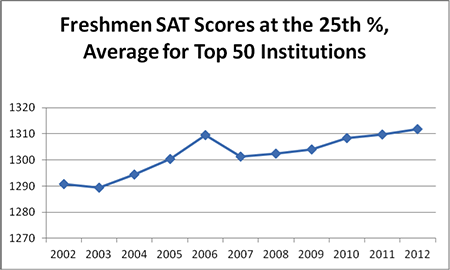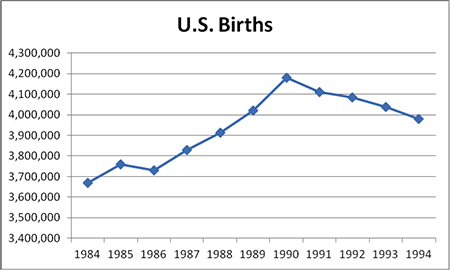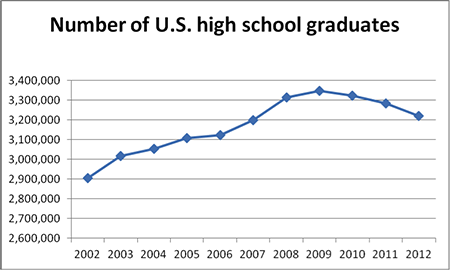Anyone who knows a teenager understands how hard it is to get into a good college these days. We’ve all heard of some bright eighteen-year-old with a stellar GPA, sky-high SAT scores, fives on a half-dozen AP courses, and a service record like Mother Theresa’s who still couldn’t manage to get into her university of choice. (Colleges mail acceptance letters this week.) What gives?
It’s particularly mysterious since national and international exams keep telling us that American high schoolers aren’t, by and large, making any significant achievement gains. Yet when it comes time to apply to college, the crème-de-la-crème appear to be rising further to the top. As proof, see this chart below. It shows, for the nation’s fifty most selective institutions,* the SAT scores that put one at the 25th percentile of the freshman class (in other words, toward the lower range of what it takes to get into these schools).

One possible explanation for this phenomenon is simple supply and demand. The demographic bulge known as the Baby Boom Echo has made its way through our high schools and into college in recent years. The supply of seats at elite colleges hasn’t increased (much to these schools’ discredit), yet demand for those seats—from well-prepared students—has gone up significantly. And that’s because there are simply more students to begin with (about a million more students per class than when I graduated high school in 1991).
To test that hypothesis, I charted the birth rate for the U.S., with an eighteen-year lag. Here’s what that looks like:

My demographic explanation looks plausible, at least through 2008 or so. From 1984 through 1990, we mostly see a steady rise in births and in elite SAT scores eighteen years later. Then births decrease, and SAT scores take a hit. But then something strange happens: Births continue to decline, but SAT scores at these colleges start to rise again. How come?
Could immigration explain it? Are foreign-born students making up for the drop in American-born kids? One way to see is by looking at the number of students graduating from high school rather than births. But as you can see below, it shows the same pattern: strong growth peaking around 2006, then a steady decline.

So what’s the answer? Honestly, I’m stumped. Here are some possibilities:
• Perhaps more of our best students are gunning for these top schools. There’s certainlyevidence that going to top-rated colleges does you more good in life than going to the ordinary kind (in terms of job prospects, grad school admissions, earnings, etc.). And applications to top schools have certainly risen sharply.
• Perhaps these top colleges are putting a greater focus on SAT scores, especially after the Supreme Court limited their ability to perform race-based affirmative action.
• Maybe American students—at least our best ones—really are learning more. (Scores on Advanced Placement exams are rising.)
• Or perhaps international students (a growing share of university student bodies) are driving up SAT averages.
If you can solve this mystery, the comments section is open.
* As defined by those with the highest SAT scores at the 25th percentile in 2002.
—Mike Petrilli
This entry originally appeared on the Fordham Institute’s Flypaper blog.


